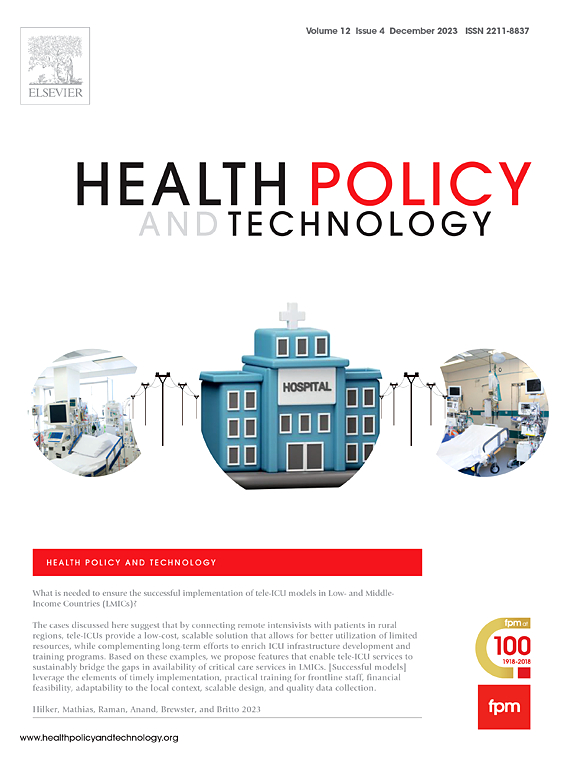促进护士对社会辅助机器人的接受、信任和伦理整合:一项准实验研究
IF 3.7
3区 医学
Q1 HEALTH POLICY & SERVICES
引用次数: 0
摘要
目的:评估不同类型的演示(无演示、视频演示和面对面演示)对护士对社交辅助机器人的接受度、信任度和伦理考虑的影响。方法:本研究采用准实验设计,涉及312名护士:201名未接触社交辅助机器人,97名通过视频演示,14名通过病房现场面对面演示。参与者完成了自我报告测量,评估他们对社会辅助机器人的道德可接受性、信任和接受度的看法。结果:与没有接触的参与者相比,接触任何形式的演示的参与者报告了明显更高的道德可接受性观念。在演示类型中,与视频演示相比,现场面对面演示的总体道德可接受性、满意度和接受度更高。结论:演示,特别是面对面的互动,在促进社会辅助机器人的道德接受度和整体接受度方面发挥着至关重要的作用。这些发现强调了将现场演示纳入提高医疗保健专业人员对机器人技术的信任和接受度的战略的重要性。本文章由计算机程序翻译,如有差异,请以英文原文为准。
Facilitating acceptance, trust, and ethical integration of socially assistive robots among nurses: A quasi-experimental study
Objectives: To evaluate the impact of different types of demonstrations (no demonstration, video demonstration, and face-to-face demonstration) on nurses’ acceptance, trust, and ethical considerations regarding socially assistive robots.
Methods: The study employed a quasi-experimental design involving 312 nurses: 201 with no exposure to socially assistive robots, 97 exposed via video demonstrations, and 14 exposed through live face-to-face demonstrations in a hospital room. Participants completed self-report measures assessing their perceptions of ethical acceptability, trust, and acceptance of socially assistive robots.
Results: Participants exposed to any kind of demonstration reported significantly higher perceptions of ethical acceptability compared to those with no exposure. Among demonstration types, live face-to-face demonstrations resulted in higher overall ethical acceptability, satisfaction, and acceptance compared to video demonstrations.
Conclusions: Demonstrations, particularly face-to-face interactions, play a crucial role in fostering ethical acceptability and overall acceptance of socially assistive robots. These findings highlight the importance of incorporating live demonstrations in strategies to improve healthcare professionals’ trust and acceptance of robotic technology.
求助全文
通过发布文献求助,成功后即可免费获取论文全文。
去求助
来源期刊

Health Policy and Technology
Medicine-Health Policy
CiteScore
9.20
自引率
3.30%
发文量
78
审稿时长
88 days
期刊介绍:
Health Policy and Technology (HPT), is the official journal of the Fellowship of Postgraduate Medicine (FPM), a cross-disciplinary journal, which focuses on past, present and future health policy and the role of technology in clinical and non-clinical national and international health environments.
HPT provides a further excellent way for the FPM to continue to make important national and international contributions to development of policy and practice within medicine and related disciplines. The aim of HPT is to publish relevant, timely and accessible articles and commentaries to support policy-makers, health professionals, health technology providers, patient groups and academia interested in health policy and technology.
Topics covered by HPT will include:
- Health technology, including drug discovery, diagnostics, medicines, devices, therapeutic delivery and eHealth systems
- Cross-national comparisons on health policy using evidence-based approaches
- National studies on health policy to determine the outcomes of technology-driven initiatives
- Cross-border eHealth including health tourism
- The digital divide in mobility, access and affordability of healthcare
- Health technology assessment (HTA) methods and tools for evaluating the effectiveness of clinical and non-clinical health technologies
- Health and eHealth indicators and benchmarks (measure/metrics) for understanding the adoption and diffusion of health technologies
- Health and eHealth models and frameworks to support policy-makers and other stakeholders in decision-making
- Stakeholder engagement with health technologies (clinical and patient/citizen buy-in)
- Regulation and health economics
 求助内容:
求助内容: 应助结果提醒方式:
应助结果提醒方式:


